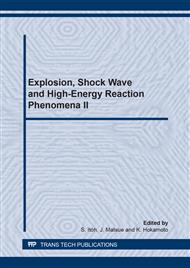p.109
p.114
p.120
p.126
p.132
p.138
p.144
p.150
p.154
Study on the Effects of Shock Wave Propagation on Explosive Forming
Abstract:
Explosive forming is one of the unconventional techniques, in which, most commonly, the water is used as the pressure transmission medium. The explosive is set at the top of the pressure vessel filled with water, and is detonated by an electric detonator. The underwater shock wave propagates through the water medium and impinges on the metal plate, which in turn, deforms. There is another pressure pulse acting on the metal plate as the secondary by product of the expansion of the gas generated by detonation of explosive. The secondary pressure pulse duration is longer and the peak pressure is lower than the primary shock pressure. However, the intensity of these pressure pulse is based also on the conditions of a pressure vessel. In order to understand the effects of the configuration of the pressure vessel on the deformation of a metal plate, numerical simulation was performed. This paper reports those results.
Info:
Periodical:
Pages:
132-137
Citation:
Online since:
July 2013
Authors:
Price:
Сopyright:
© 2014 Trans Tech Publications Ltd. All Rights Reserved
Share:
Citation:


